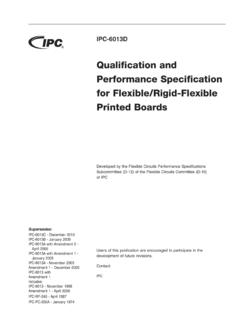Transcription of Modeling of an Electric Vehicle Thermal Management System ...
1 AbstractElectric vehicles (EVs) need highly optimized Thermal Management systems to improve range. Climate control can reduce Vehicle efficiency and range by more than 50%. Due to the relative shortage of waste heat, heating the passenger cabin in EVs is difficult. Cabin cooling can take a high portion of the energy available in the battery. Compared to internal combustion engine-driven vehicles, different heating methods and more efficient cooling methods are needed, which can make EV Thermal Management systems more complex. More complex systems typically allow various alternative modes of operation that can be selected based on driving and ambient conditions. A good System simulation tool can greatly reduce the time and expense for developing these complex systems. A simulation model should also be able to efficiently co-simulate with Vehicle simulation programs, and should be applicable for evaluating various control algorithms.
2 The MATLAB/Simulink dynamic System simulation environment, widely used in the automotive industry, effectively meets these model the full EV Thermal Management System , the National Renewable Energy Laboratory's air-conditioning model now incorporates liquid-coolant System components. In the full System model, lookup tables were used to characterize the components' performance. Predicted data obtained with the System simulation model were compared against experimental data. An agreement within 5% for most of the System parameters was achieved. The validated System model was then used to determine which of two possible locations for the power electronics and Electric motor in the System is better for quick cabin heating starting from cold improving Vehicle efficiency, Thermal systems are increasingly important for effective and efficient heavy- and light-duty Vehicle design. Developing flexible and cost-effective tools to understand Vehicle Thermal trade-offs at the System level is critical to designing advanced electrified traction drive systems and their associated Thermal operating, the air conditioning (A/C) System is the largest auxiliary load on a conventional Vehicle .
3 A/C loads account for more than 5% of the fuel used annually for light-duty vehicles in the United States [1]. Climate control loads can have an even larger impact on hybrid Electric Vehicle , plug-in hybrid Electric Vehicle , and all- Electric Vehicle (EV) performance. Hybrid EVs have 22% lower fuel economy with the A/C on [2 ]. For all- Electric vehicles, the effect of the climate control System can be even more severe. Due to the relative shortage of waste heat, heating the passenger cabin in EVs is difficult. Cooling the cabin can take a high portion of the energy available in the battery, significantly reducing Vehicle efficiency and range. Mitsubishi reports that the range of the i-MiEV can be reduced by as much as 68% for heating and 46% for cooling on the Japan 10-15 cycle [3]. The Advanced Powertrain Research Facility at Argonne National Laboratory has reported and reductions in range due to maximum heating and maximum cooling, respectively, for the Ford Focus EV operating on the Urban Dynamometer Driving Schedule cycle [4].
4 In addition to these climate control impacts, Electric -drive vehicles (EDVs) may have additional cooling requirements for the Electric traction drive System components, including batteries, power electronics, and Electric , compared to internal combustion engine-driven vehicles, different heating methods and more efficient cooling methods are needed for EVs. These methods often involve running the A/C System in heat pump mode for sufficient heating of the cabin. In some advanced concepts, the traditional liquid coolant-based Thermal Management is supplemented with the refrigerant-based cooling System , which can make the Thermal Management System more complex. When developing a Thermal Management System for an internal combustion engine Vehicle , it has traditionally been sufficient to run models of the A/C System and the liquid coolant-based cooling System separately. For advanced vehicles, especially for hybrid and all- Electric vehicles, the interconnectedness of the Thermal systems requires a more integrated simulation more complex Thermal Management systems of advanced vehicles typically allow for various alternative modes of operation that can be selected based on driving and ambient conditions.
5 Investigating a number of System alternatives and determining the Modeling of an Electric Vehicle Thermal Management System in MATLAB/Simulink2015-01-1708 Published 04/14/2015 Tibor Kiss, Jason Lustbader, and Daniel LeightonNational Renewable Energy LaboratoryCITATION: Kiss, T., Lustbader, J., and Leighton, D., " Modeling of an Electric Vehicle Thermal Management System in MATLAB/Simulink," SAE Technical Paper 2015-01-1708, 2015, 2015 SAE InternationalNREL/CP-5400-63419. Posted with permission. Presented at the SAE 2015 World Congress & Exhibition, 21 23 April 2015, Detroit, Michigan. best ranges for the various operating modes with experimental methods can be very time consuming. A good System simulation tool can greatly reduce the time and expense spent on the development of these complex systems. A simulation model should also be able to efficiently co-simulate with Vehicle simulation programs and should be well applicable for evaluating various control algorithms.
6 The MATLAB/Simulink dynamic System simulation environment is well suited for such System simulation models because it is widely used in the automotive industry and effectively meets these Modeling MethodsTo meet the needs of advanced Vehicle Thermal System simulation , the National Renewable Energy Laboratory ( nrel ) is building on previously developed Simulink A/C models, adding liquid coolant loops to enable integrated System simulation . Simulink is a common engineering platform that allows for co- simulation with Autonomie [5]. nrel previously developed CoolSim, an A/C System simulation Modeling framework in MATLAB/Simulink and validated its performance against test bench data. To match the wide range of A/C Modeling needs, nrel developed models with three different levels of detail: the Fully-Detailed, Quasi-Transient, and Mapped-Component models, illustrated in Figure 1. Previously developed A/C System model versionsIn the trade-off of speed and accuracy, the three models occupy very different parts of the scale and meet a wide range of Modeling needs.
7 The Fully-Detailed model captures the detailed System transient behavior but runs at real-time speed [6]. The Quasi-Transient and Mapped-Component models are progressively more simplified while trying to maintain accuracy and run at real-time speed and greater than 10 times real-time speed, respectively [7]. The goal of these new model versions was to provide faster simulation tools for less detailed, Vehicle -focused drive-cycle-based evaluation of A/C systems. For steady-state conditions, the Quasi-Transient model provides essentially the same accuracy as the Fully-Detailed model. The Mapped-Component model does lose some accuracy in steady-state conditions. For the SC03 cycle, the averaged results of power and heat exchange rates obtained with the Quasi-Transient model are within 3% of the results of the Fully-Detailed model. The Mapped-Component model results are within 15% of the results of the Fully-Detailed model. Short transients, such as those occurring during compressor cycling, produce the most deviation from the Fully-Detailed model for both simplified models.
8 Conversion from one A/C System model approach to another of the three models is relatively simple. This allows a new System model to be developed in a faster version before the results are refined using a slower, more detailed solution method as outlined in the Introduction, there is a need for full Thermal System simulation due to the interconnectedness of the refrigerant and liquid coolant circuits used in advanced Thermal Management systems, especially for EVs. Therefore, nrel 's refrigerant circuit simulation model was extended with a liquid-coolant circuit simulation capability. The Quasi-Transient and the Mapped-Component model versions of the A/C System simulation were used as the basis of the extension because they are the best fit in terms of model execution speed and accuracy. The new model was applied to an experimental advanced all- Electric Vehicle Thermal Management System . Comparison of simulated results to measured data validated this particular System model and also the Modeling methodology in the Liquid Coolant-Based SystemSolving the single-phase liquid coolant circuit model requires determining the coolant flow through the various branches in the System and the heat transfer of the components.
9 These two aspects of the Modeling will be discussed in the next two subsectionsDetermining the Coolant Flow Rates throughout the SystemSome important processes in the liquid coolant part of the Thermal Management System take place over minutes and longer time periods. Therefore, it is important that the simulation model is able to run at near real-time speed. The two-phase refrigerant circuit model is already difficult to solve at such speed. It is therefore important that the liquid coolant simulation run as fast as possible on its own, so that together, the full System model has adequate speed. Pressure wave line dynamics are not important in the liquid coolant flow; therefore, an incompressible flow formulation was selected. This allows for a larger simulation time step. The Quasi-Transient and the Mapped-Component refrigerant circuit simulations can also use this larger time step. In Simulink, it is difficult to have two parts of the model run at different simulation time steps; therefore, it makes sense to have the two model formulations run optimally with the same the development of a Thermal System , various options for System design and operating modes may be investigated.
10 Therefore, providing model flexibility is important. To achieve this coolant circuit flexibility, the liquid coolant fluid of the Thermal System was modeled as a generic fluid network with loops and branches in which the flow rates are determined by the pressure changes (losses and rises) through various components ( , transport lines, heat exchangers, valves, pump) in the System (Figure 2).To solve for the flows in a complex fluid network, two main sets of equations are considered: nodal continuity and loop equations. One continuity equation is written for each node, which states that the sum of the incoming flow rates should equal zero. For each fluid loop, an equation is written that states that the sum of pressure changes in each branch around the fluid loop should equal zero. These equations are analogous to the Kirchhoff laws for Electric circuit theory, where they are written for the total incoming current in the nodes and for the sum of Electric potential drop around conductor loops.












